Categories > Guides and Tips

Safe Driving in Thailand: A Complete Guide [2023]
If you’re a foreigner who plans on renting a car and then driving around to explore Thailand, there are some things you should know before hitting the roads! The most important thing is that you should have an International Driver’s Permit,
Once you’ve got that covered, it’s time to learn how to manoeuvre Thailand’s roads like a pro for your own safety. It’s no myth that this country is one of the unsafest in the world to drive in – so what can you do to ensure your safety on the road?
Safe driving in Thailand starts with learning about the road conditions, traffic laws, and habits of the local drivers.
For example, it’s important to note that in Thailand, driving is on the left-hand side of the road. Also, be prepared for the chaos of motorbikes weaving in and out of traffic.
By following these tips, you can confidently navigate Thailand’s roads and enjoy your travels to the fullest. So, let’s hit the road in Thailand and dive into everything you need to know to confidently navigate Thailand’s highways.
Manoeuvring the Streets of Thailand: What You Need to Consider
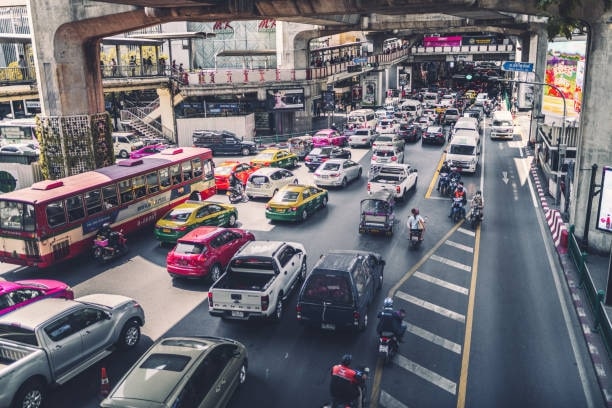
Navigating the streets of Thailand can be a thrilling experience, but it can also be overwhelming for first-time drivers. From laws to traffic jams, driving in Thailand requires a certain level of adaptability and caution.
Here, we’ll give you some insider tips and tricks for safely manoeuvring the roads of Thailand, so you can have a stress-free and enjoyable driving experience.
1. Thailand has diverse road conditions
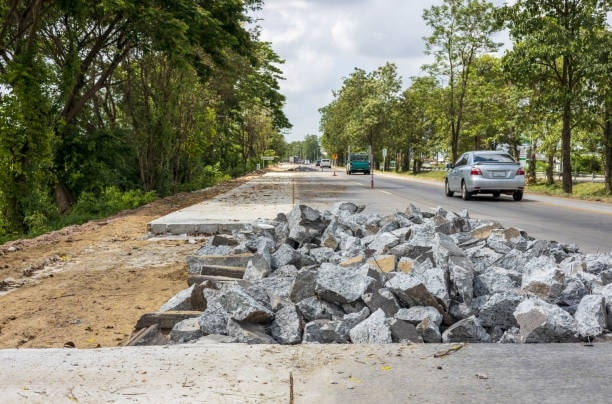
Highways in Thailand are generally well-maintained and easy to navigate, but traffic can be heavy at times. On the other hand, rural roads can be narrow, winding, and poorly lit. It’s essential to drive with caution on these roads, especially at night.
Another thing to watch out for is the weather. Thailand’s rainy season, which lasts from May to October, can lead to flooded roads and landslides. Drivers need to be extra careful during this time and plan their routes accordingly.
Local tip: Always stay vigilant of bad road conditions, such as potholes, loose gravel, and debris, regardless of the type of road you’re driving on.
2. There are many narrow and tricky-to-navigate streets all over Thailand
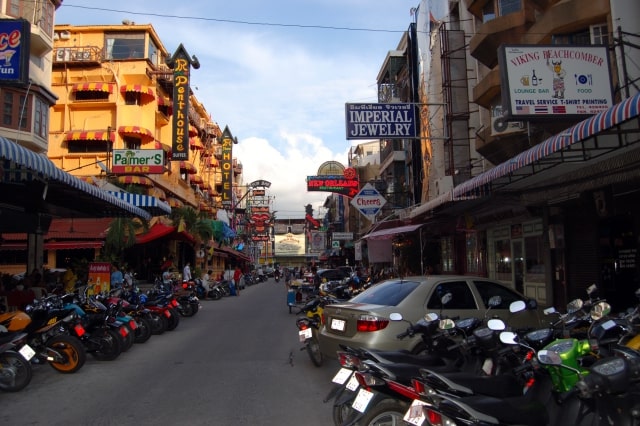
Driving through narrow streets or sois in Thailand can be a bit intimidating for new drivers, but it’s a skill that can be mastered with practice.
When navigating through small sois, it’s important to take it slow and stay alert, as the streets can be crowded with pedestrians, motorbikes, and parked cars.
One of the key things to keep in mind is to be patient and avoid sudden movements. Sois can be narrow and winding, so take your time and watch out for obstacles.
It’s also important to be aware of parking regulations in sois. Many areas have designated parking spaces or times when parking is allowed, so make sure to pay attention to signs and avoid parking in no-parking zones.
3. Soi dogs are common on Thai roads

Soi dogs, as they are called in Thailand, are a common sight on the country’s streets and highways.
While most soi dogs are friendly and docile, it’s important to exercise caution when driving near them. They may suddenly dart out into the road, putting both themselves and drivers at risk.
Here are some tips for sharing the road with soi dogs:
- Slow down: When approaching an area known for soi dogs, slow down your vehicle. This gives you more time to react in case a dog runs out into the road.
- Use your horn: If you see a soi dog near the road, honk your horn to scare it away. This can help prevent it from running into the road.
- Avoid sudden movements: If a soi dog does run out into the road in front of you, avoid sudden movements. Stay calm, slow down gradually, and move to the side of the road if possible.
- Keep your distance: Never try to pet or feed a soi dog while driving. Keep a safe distance and avoid making direct eye contact, as it can be seen as a threat.
4. Rainy season poses higher risks due to flooded streets
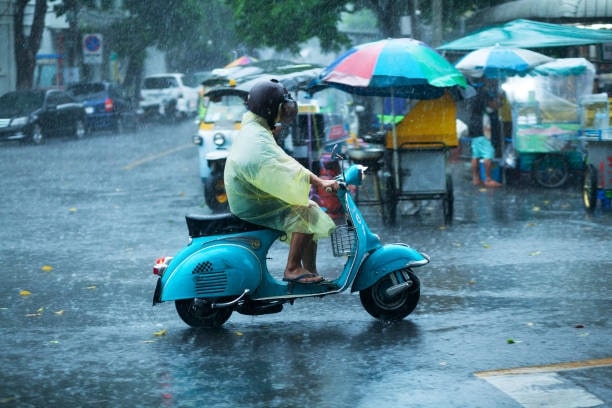
Driving during heavy rain in Thailand can be a challenging and risky experience, especially for those who are not accustomed to the local weather and driving conditions.
The rainy season in Thailand typically lasts from May to October, and during this time, drivers must take extra precautions to ensure their safety on the road.
Remember the basic things you’ve learned in driver’s ed class when driving in heavy rain: drive slow, use your headlights, and don’t make sharp turns.
Bangkok, in particular, is prone to flooding – even their elevated highways get flooded! So when it’s raining extra heavy, be extra cautious when driving through flooded areas, and avoid driving through it altogether if the water level is too high.
Find an elevated establishment where you can park or pull over to avoid getting stuck on the road.
5. Many roads are very congested during rush hour.
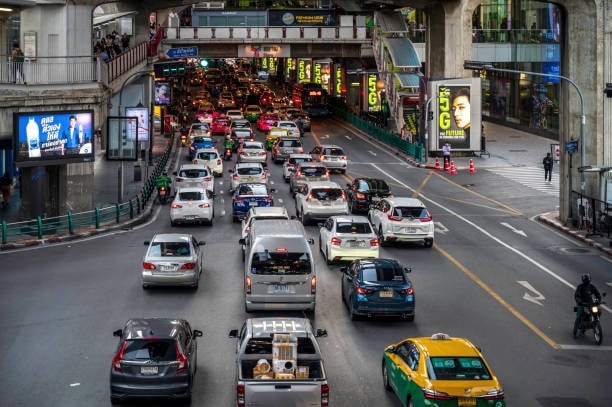
With so many cars, motorbikes, and other vehicles sharing the roads of Thailand, navigating through the traffic can be a daunting task for drivers.
But don’t worry, we’ve got some tips to help make your driving experience in Thailand a little bit easier.
First and foremost, it’s important to stay alert and patient. Getting angry or aggressive will only make things worse. It’s best to remain calm and avoid sudden movements, especially when changing lanes or turning.
Another useful tip is to plan ahead and leave early to avoid rush hour traffic. Rush hour in Thailand typically occurs between 7:00 AM to 9:00 AM and 4:00 to 7:00 PM, and the roads can get extremely crowded during these times.
Lastly, many major cities in Thailand have toll roads or expressways that can help you avoid some of the traffic. However, these roads often require payment, so be sure to have enough cash or a pre-paid pass to cover the tolls.
6. Thailand follows left-hand traffic system
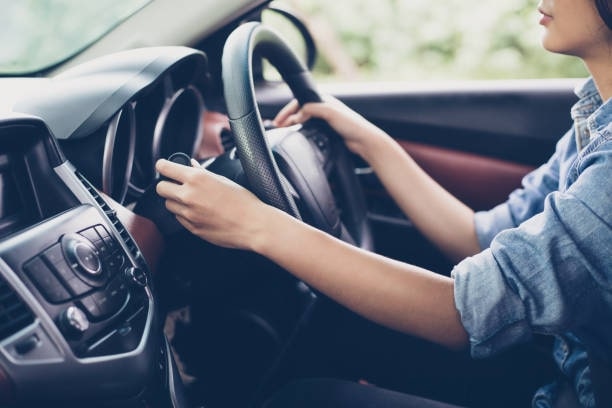
Driving on the left side of the road can be a challenging experience for those accustomed to driving on the right. This is the case in countries such as Thailand, the United Kingdom, and Australia, among others.
When driving on the left side of the road, it’s essential to remember that the driver’s seat is on the right-hand side of the car. This can take some getting used to, as can shifting gears with the opposite hand.
Additionally, traffic flow can be different from what you’re used to, with left-hand turns being more prevalent than right-hand turns in some areas. It’s important to pay attention to road signs and signals to avoid confusion.
It’s worth noting that in Thailand, where driving is on the left side of the road, it’s common to see mopeds or scooters going against the flow of traffic for shortcuts such as U-turns.
Local tip: Practise driving on quiet roads before venturing out into busier areas. This will help you get comfortable with the different driving styles and develop confidence.
7. Bangkok has an extensive expressway network
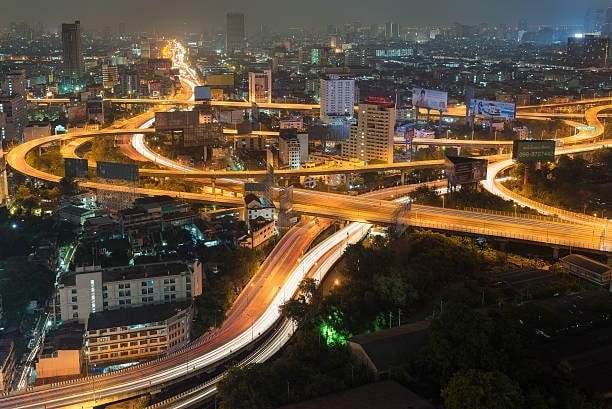
If you’re driving in Bangkok, you’ll likely encounter the city’s extensive network of expressways.
These elevated highways are a fast and efficient way to get around the city, but they can be overwhelming for newcomers.
Here are some tips for mastering Bangkok’s expressways:
- Plan your route ahead of time: Before you hit the road, make sure you know which expressways you’ll be taking and where your exits are. Use a GPS or map to help you navigate.
- Pay attention to signs: The signs on Bangkok’s expressways can be confusing, especially if you’re not used to driving in the city. Keep an eye out for exit signs, toll booth signs, and speed limit signs.
- Watch your speed: The speed limit on Bangkok’s expressways is 90 km/h (56 mph), but many drivers go much faster than that. Stay in the right lane and let faster drivers pass you on the left.
- Prepare for tolls: Most of Bangkok’s expressways are tolled, so make sure you have plenty of small bills and coins on hand. Toll prices vary depending on the distance you travel.
- Be aware of rush hour: Bangkok’s expressways can get very congested during rush hour, especially near the exits to popular business districts. Try to avoid driving during peak traffic times if possible.
8. An Easy Pass (ETC) is essential for those who frequently go through tollways in Thailand
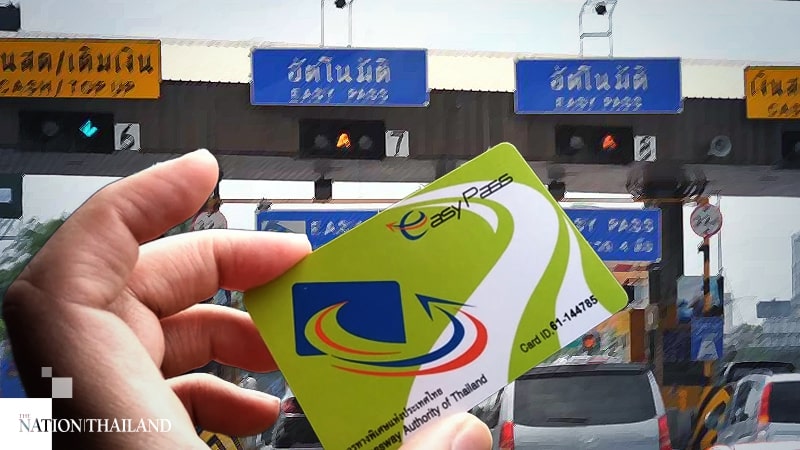
If you’re someone who frequently uses tollways in Thailand, getting an Easy Pass can be a game changer for you. This is a pre-paid ETC (electronic toll collection) card that offers a more convenient way to pay tolls.
With an Easy Pass, you can enjoy the convenience of travelling on Bangkok’s expressways without the hassle of stopping to pay toll fees.
To obtain an Easy Pass for Bangkok’s expressways, there are several steps you need to follow.
Step 1: Prepare necessary documents including passport, car registration, and an initial deposit of 300 THB.
Step 2: Visit an Easy Pass service centre at selected locations or purchase online through the website.
Step 3: Complete the registration process by providing personal and vehicle information.
Step 4: Receive an Easy Pass card, OBU device, and installation instructions.
Step 5: Top-up the card balance through various channels including online banking or convenience stores.
Step 6: Install the OBU device in your car according to the instructions provided.
Step 7: Once your account is activated, you can start using your Easy Pass to pay for toll fees on the expressways.
NOTE: Remember to top up your account regularly to ensure that you have enough balance for your travels.
9. The M Flow in Bangkok’s Motorway 9 (Bang Pa-In-Bang Phli) makes using tollways a breeze
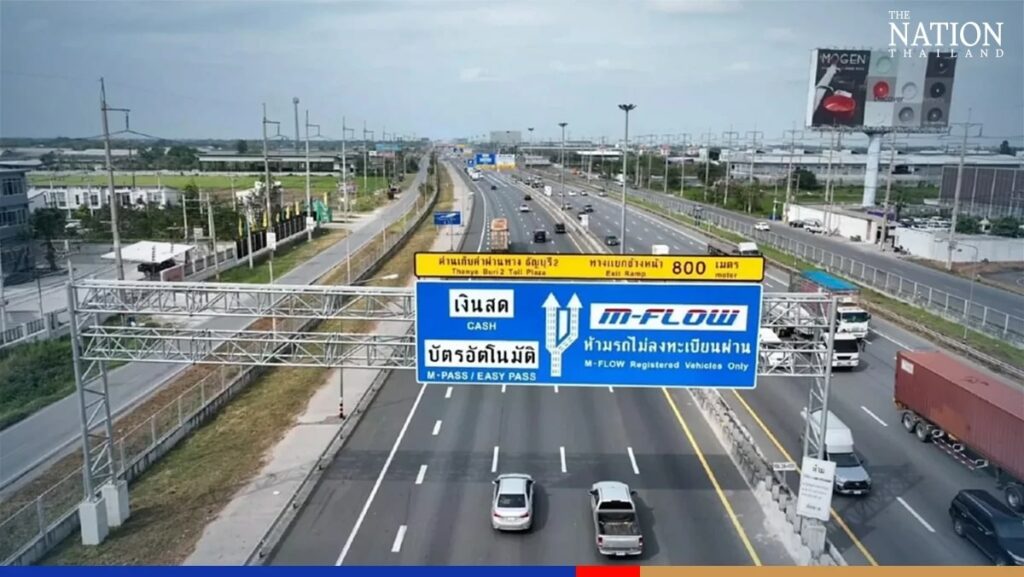
With the M Flow, there’s no need to stop or slow down to pay at toll gates. Instead, video cameras capture your car’s licence plate as you drive through an M Flow gate.
However, it’s currently only available at Motorway 9 (Bang Pa-In-Bang Phli) at the gates of Thap Chang 1, 2 and Thanyaburi 1 and 2 that connect Bangkok to surrounding districts.
To use the M-Flow, there are several steps you need to follow:
Step 1: You’ll need to upgrade your Easy Pass to an Easy Pass Plus account by creating an account on the Thai Easy Pass website and adding your car information, phone number, and email.
Step 2: You’ll also need a smart card number and OBU number that come with your Easy Pass card.
Step 3: Once it’s set up, you won’t have to worry about paying at toll gates anymore. The toll fee will be automatically deducted from your Easy Pass every time you use M Flow.
NOTE: All processes are currently only available in Thai. So, if you can’t read Thai, you may need some help from your Thai friends to set it up.
Tips for Avoiding Accidents when Navigating Thai Roads
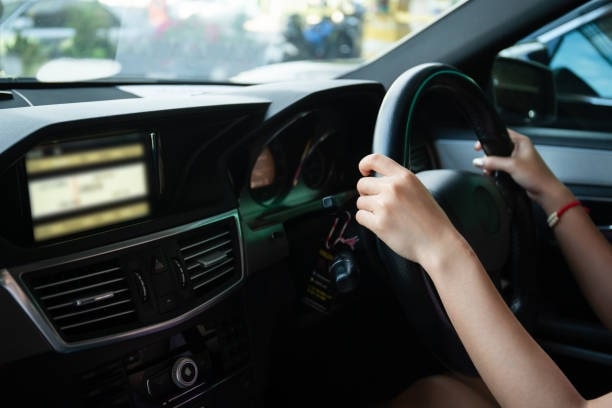
Driving in Thailand requires more than just following traffic rules and regulations. It also involves understanding and following proper driving etiquette and gestures.
In Thailand, driving etiquette is highly valued, and motorists are expected to be courteous and respectful to one another on the road.
This includes using appropriate hand signals, avoiding aggressive driving, and being mindful of other drivers’ needs.
Another is the head nod, which is frequently used by motorbike riders. Since it can be tough to see the driver inside a car due to tinted windows, this gesture is mostly used by those on motorbikes.
If someone gives you a nod by tilting their head up, it means they’re giving you the right of way. You can respond by bowing your head with a simple downward nod to show appreciation and thank them for the right of way.
On the other hand, you may also come across other drivers bowing with a head nod down, indicating that they’re taking the right of way.
1. Use hazard lights for emergencies and temporary parking
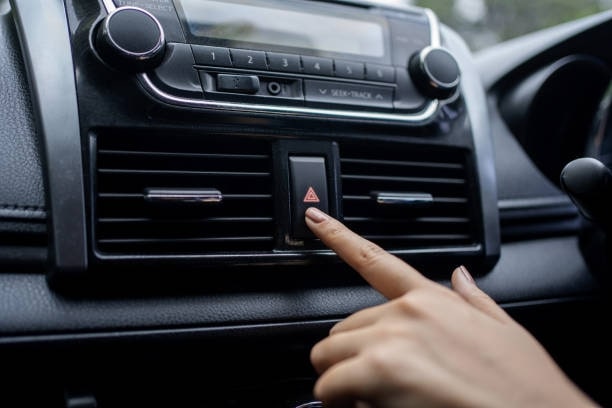
Hazard lights, also known as emergency lights, are typically activated by pressing a button on your dashboard and are designed to warn other drivers of a potential danger or emergency.
In Thailand, Thais often use hazard lights when they need to slow down or stop on the side of the road, such as when they’re changing a tire or their car is experiencing some trouble.
They can also be handy during heavy rain or fog, improving visibility for everyone on the road.
Also, hazard lights are sometimes used by drivers to express gratitude by briefly flashing them as a form of “thank you”.
But keep in mind that hazard lights should not be used instead of turn signals or as a way to signal turns. This can be dangerous and confusing for other drivers, especially in heavy traffic or on highways.
So use them wisely and stay safe on the road!
2. Don’t follow emergency vehicles when you’re stuck in traffic
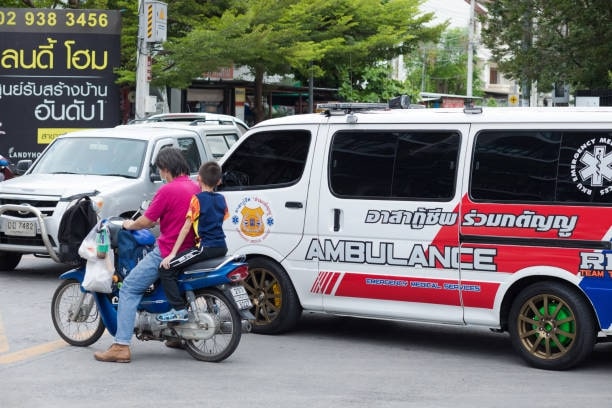
When driving, it’s important to be aware of emergency vehicles such as ambulances, fire trucks, and police cars. These vehicles often have to travel quickly to reach their destination, and it’s crucial for other drivers to yield and give them enough space to do so safely.
Emergency vehicles in Thailand are equipped with sirens and flashing lights to signal their approach. If you hear or see an emergency vehicle, you should immediately pull over to the side of the road and stop.
However, due to heavy traffic, drivers often struggle to find a place to pull over in Thailand’s cities, resulting in the law being disregarded at times.
But, if you have the space for it, make sure to check your surroundings for other emergency vehicles before proceeding.
It’s also important to note that you should never try to follow or pass an emergency vehicle. Doing so can be dangerous and may hinder the progress of the emergency responders.
In addition, make sure to avoid blocking intersections or crosswalks, as this can delay emergency vehicles and cause unnecessary risk to others.
3. Take turns and give way to other vehicles on the road
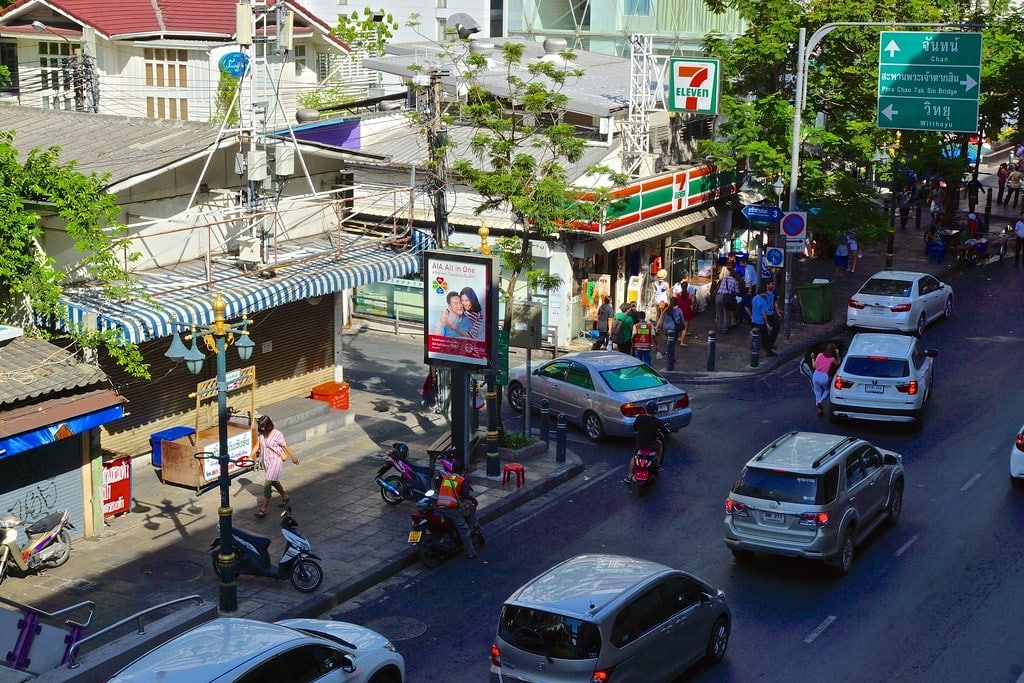
When driving on the roads, it’s important to know who has the right of way. In other words, who has priority to proceed when two vehicles meet at an intersection or merge onto the same road.
In Thailand, the general rule is that vehicles coming from the right have the right of way. However, this can vary depending on the situation and the specific road rules in place.
It’s important to always be aware of other vehicles on the road and communicate your intentions with hand signals or turn signals. This helps to avoid confusion and potential accidents.
4. Watch out for motorbikes weaving through cars in traffic
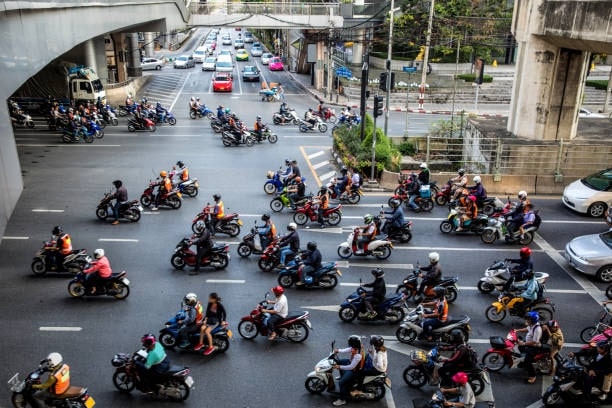
Motorbikes are a popular mode of transportation in Thailand, and it’s essential to be aware of them while driving.
One of the most important things to keep in mind is that motorbikes in Thailand often weave in and out of traffic and drive on the wrong side of the road. It’s crucial to keep a close eye on your surroundings, especially when changing lanes or turning.
Another important tip is to give motorbikes plenty of space. Motorbikes are smaller and more agile than cars, and they can easily squeeze into tight spaces. Always assume that there may be a motorbike nearby and leave enough room for them to pass.
It’s also important to note that many motorbike riders in Thailand don’t wear helmets, which can be a dangerous situation for them in the event of an accident.
7. Learn how to safely pass other vehicles on the road
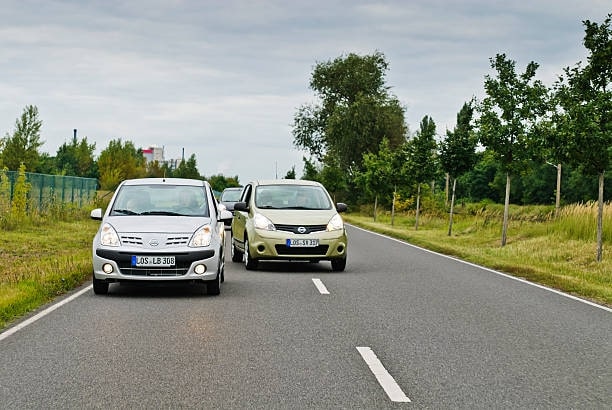
In Thailand, passing can be particularly challenging due to the congested roads and the prevalence of motorbikes and scooters. Here are some tips for passing other vehicles on Thai roads.
First and foremost, it’s important to pay attention to the road ahead and anticipate when you will need to pass. Look for signs indicating passing zones, such as broken lines or arrows, and be aware of oncoming traffic.
When passing, always use your turn signal to indicate your intention to change lanes. Check your mirrors and blind spots before making your move, and be sure to leave plenty of space between your vehicle and the one you’re passing.
Another important thing to keep in mind is to pass quickly and efficiently. Don’t linger in the passing lane, as this can create a hazard for other drivers.
Once you have passed, signal your intention to return to your original lane and merge back safely.
Finally, always be aware of your surroundings and adjust your speed and position as necessary. If you encounter unexpected obstacles or hazards, such as potholes or debris in the road, slow down and proceed with caution.
8. Stay alert to local drivers’ risky habits
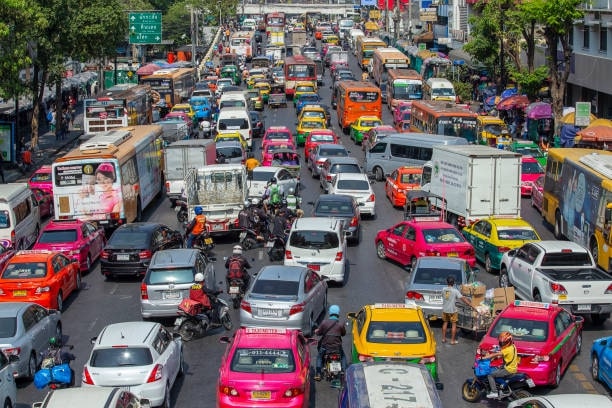
One of the most important things to keep in mind when driving in Thailand is to be aware of the risky driving habits of local drivers.
You may encounter sudden lane changes, reckless driving, and even driving on the wrong side of the road. Overtaking on narrow roads is also a common occurrence.
To stay safe on the road, it’s important to keep a safe distance from other drivers and anticipate their moves.
This means being alert and attentive at all times, and keeping a close eye on your surroundings. Always use your mirrors and be aware of blind spots, especially when changing lanes or turning.
9. Understand the routes to your destination before heading out
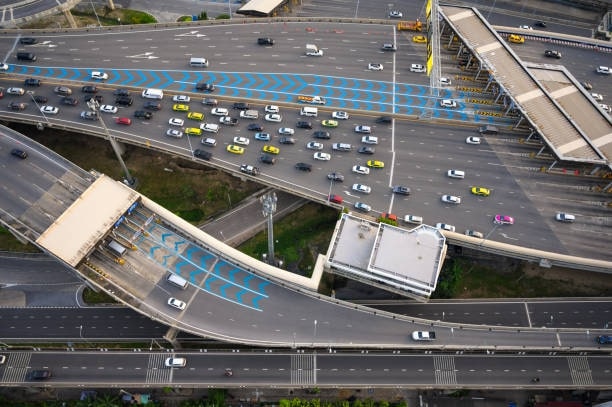
Understand the routes you will take each day to avoid being caught off guard by one-way roads and unexpected turns.
Drive with the flow of traffic and stay aware of smaller vehicles such as tuk-tuks, taxi services, and motorbikes.
You should also keep in mind that different cities and provinces in Thailand have different driving styles and etiquette. For instance, Bangkok drivers tend to be more aggressive, while drivers in Chiang Mai have a more relaxed driving style.
So, when travelling between cities, it’s a good idea to match the driving style and mentality of the particular city you’re in to avoid disrupting the flow of traffic.
Thai Traffic Laws and Signs: What You Need to Know
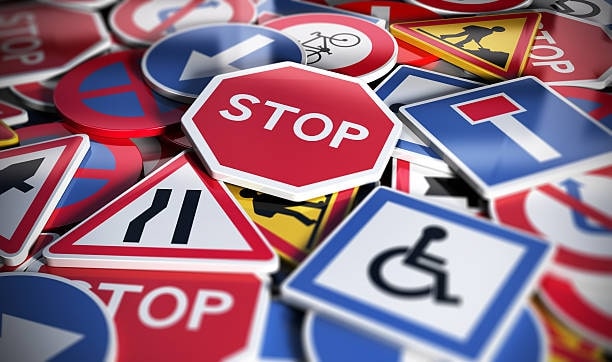
The traffic laws in Thailand may differ from what you are used to in your home country, so it’s essential to have a good understanding of them before hitting the road.
Here’s an overview of some of the most important traffic laws and regulations in Thailand that you need to know as a driver.
1. The average speed is 90 km/h on Thai highways
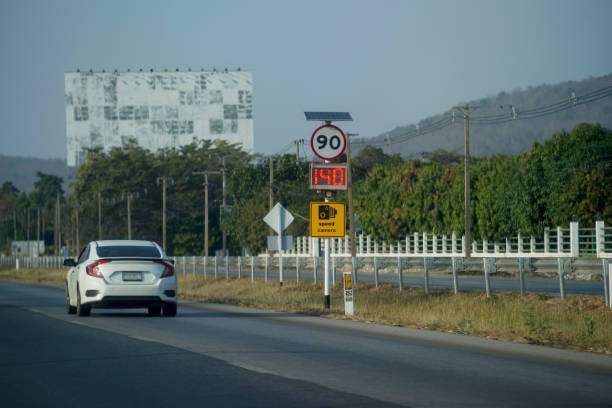
Just like in any country, it’s important to follow the prescribed speed limits on highways to ensure your safety and avoid any penalties for breaking the law in Thailand.
The speed limits can vary depending on the type of highway and the location.
The prescribed speed limit for standard four-wheeled vehicles on highways in Thailand is 100 km/h, while buses, public transportation, and trucks weighing less than 2.2 tons are only allowed to go up to 80 km/h.
However, it’s important to note that the speed limit can be lower in certain areas, such as construction zones or areas with heavy traffic. It’s also important to be aware of any posted signs indicating speed limits or other regulations.
2. 90 km/h is the maximum speed limit on city roads in Thailand
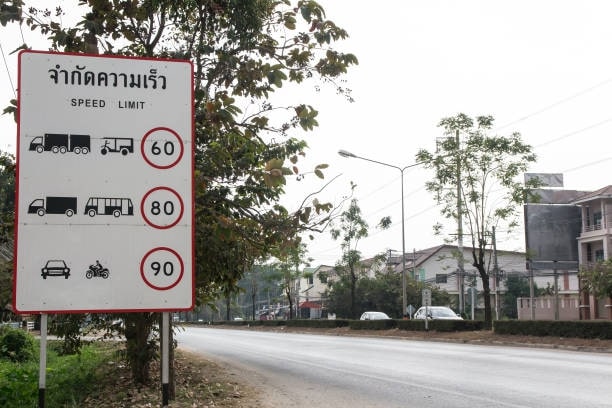
The maximum speed limit in cities in Thailand is generally 90 km/h, although it may be lower in certain areas.
It’s important to note that speed limits can vary depending on the time of day and traffic conditions. For example, in some areas, the speed limit may be reduced during rush hour to reduce the risk of accidents.
It’s also worth noting that certain roads may have lower speed limits posted, such as school zones or areas with heavy pedestrian traffic.
3. Lane markings matter a lot

Lane markings are painted lines on the road that indicate the boundaries of each lane. They help drivers stay in their designated lanes and prevent accidents from happening.
In Thailand, there are typically three types of lane markings: solid white lines, broken white lines, and yellow lines. It’s important to always be aware of the lane markings and follow them accordingly.
Failure to do so can result in fines and even accidents. Additionally, it’s important to remember to always use your turn signals when changing lanes, even if it’s just a slight movement within your lane.
| Lane Marking | Description | Meaning |
|---|---|---|
| Solid White Line | A continuous white line that marks the outer edge of a lane | Do not cross, helps drivers maintain lane discipline |
| Dashed White Line | A white line with short dashes that marks the inner edge of a lane | Safe to change lanes if it is safe to do so |
| Solid Yellow Line | A continuous yellow line that marks the outer edge of a lane or separates opposing lanes of traffic | Do not cross, no passing |
| Dashed Yellow Line | A yellow line with short dashes that marks the inner edge of a lane or separates opposing lanes of traffic | Passing allowed if it is safe to do so |
| Double Solid Yellow Line | Two continuous yellow lines that mark the centre of a two-way road | Do not cross, no passing allowed from either direction |
| Double Dashed Yellow Line | Two yellow lines with short dashes that mark the centre of a two-way road | Passing allowed if it is safe to do so from either direction |
| Zigzag Markings | Two perpendicular zigzag lines along the road, with some horizontal lines in the middle | Do not load or unload in these areas since this will block the view of pedestrians crossing the road |
4. Follow the stop signs Thailand
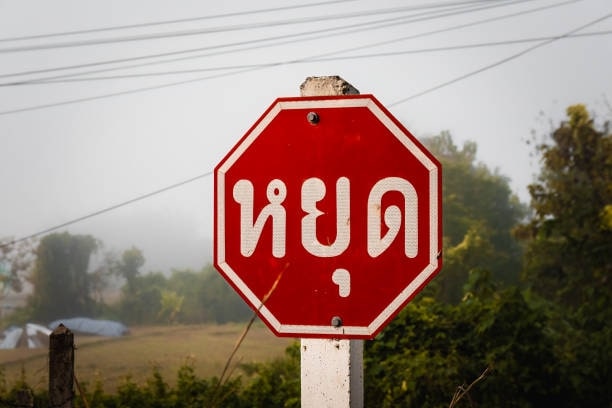
Stop signs are a common sight on roads and intersections in Thailand. These signs play a critical role in ensuring the safety of motorists and pedestrians by instructing drivers to come to a complete stop at a designated point.
These signs are red octagonal signs with the word “stop” written in both Thai and English. They are typically found at intersections, crosswalks, and other areas where it is necessary to control traffic flow.
5. Yield to the vehicle on the right when stop signs are not available
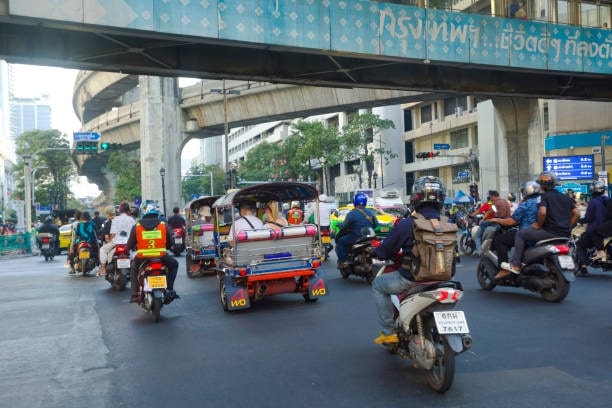
Intersections without stop signs are usually controlled by traffic lights or roundabouts, but there are also many intersections where there are no traffic control devices at all.
When driving at intersections without stop signs, it’s important to be extra cautious and to keep an eye out for other drivers, pedestrians, and motorcyclists.
The general rule is to yield to the vehicle on the right, but it’s also important to be aware of any vehicles coming from other directions.
It’s also important to remember that even if you have the right of way, it’s still important to drive defensively and to be prepared to stop or yield if necessary.
In Thailand, many drivers are known to run red lights or ignore other traffic signals, so it’s always best to err on the side of caution.
6. Traffic cameras are installed on many Thai roads
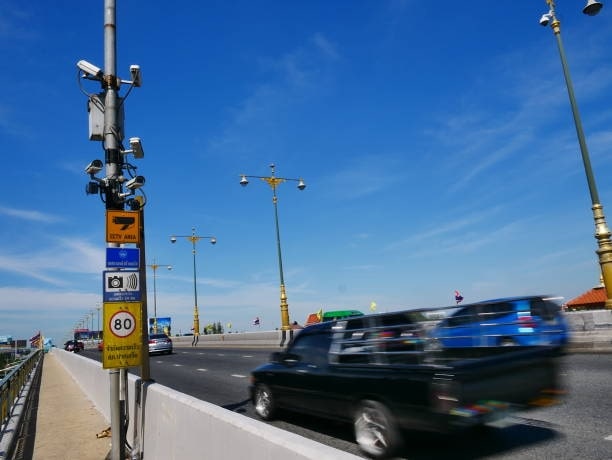
Traffic cameras are installed throughout Thailand to help enforce traffic laws and catch violators. They can capture images of vehicles and their licence plates, and if you violate a traffic law, a ticket will be mailed to the registered owner’s address.
Remember that these cameras can also capture violations that occur at red lights and while driving in bus lanes. So always be aware of your surroundings and follow traffic rules to avoid getting a ticket in the mail.
7. Your IDP and driver’s licence should be with you at all times
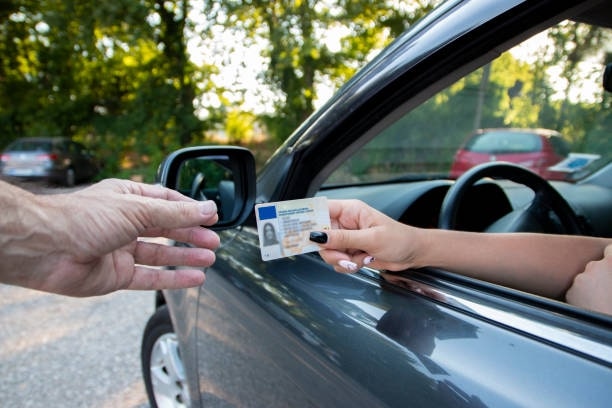
You will need to carry both your IDP and your driver’s licence with you at all times when driving in Thailand.
It’s illegal to use a licence from your home country to drive in Thailand, and violators risk a minimum fine of THB500. Also, insurance providers won’t cover drivers who lack a Thai driver’s licence or IDP.
People holding a driver’s licence from an ASEAN country are exempted from this rule, however.
Another thing to keep in mind is that the IDP is only valid for one year from the date of issue, so you will need to renew it annually if you plan to continue driving in Thailand.
8. The type of traffic police can be determined through their helmets
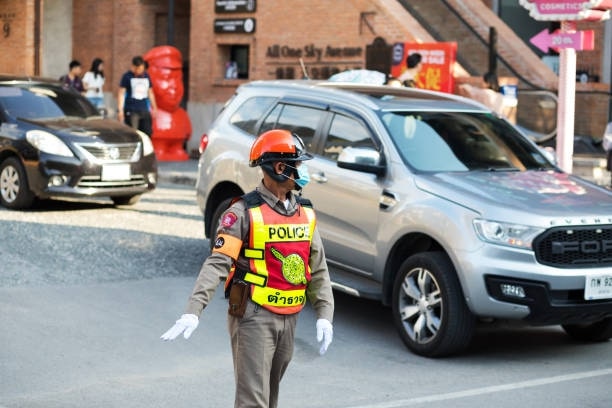
In Thailand, traffic laws are enforced differently. Instead of pulling over individual vehicles, police checkpoints are set up throughout the city and major highways.
These checkpoints are often placed in difficult-to-spot locations like blind corners or at province borders on highways. If a driver in the opposite lane flashes their high beams a few times, it’s a signal that there’s a police checkpoint ahead.
Additionally, the colour of the officer’s helmet can indicate the type of checkpoint; white helmets for traffic police and gold helmets for officers enforcing laws on illegal substances or other serious infractions.
Plus, when you receive a ticket, don’t argue or try to bribe the officer. Simply accept the ticket and pay the fine at a designated location within a specified time frame. Failure to do so may result in legal consequences, such as an arrest warrant.
It’s also worth noting that some traffic police officers may not speak fluent English, so it’s helpful to have a basic understanding of Thai or bring along a Thai-speaking friend or translator.
9. Tickets for penalties and fines are processed between 7 to 14 days
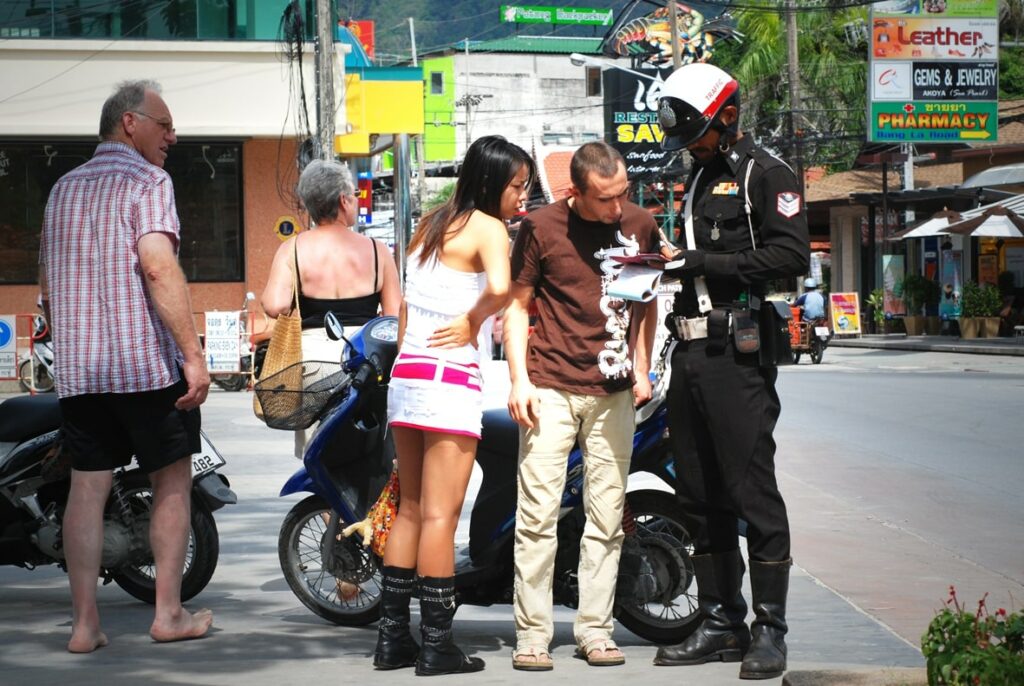
If you receive a traffic ticket, it’s important to handle it properly to avoid any additional legal issues.
To pay a ticket in Thailand, you will typically have a window of 7 to 14 days. Payment can be made at a police station, post office, or through your bank app by selecting “Royal Thai Police – Police Ticket” under the “payment” menu.
If you’re given the option to pay on the spot, such as at highway checkpoints, make sure to obtain an official receipt for the transaction.
When you receive a ticket for a specific offence and get pulled over again for the same offence shortly thereafter, you can show the police officer your ticket to demonstrate that you’re in the process of resolving the issue.
This is likely to prevent you from receiving another ticket.
| Traffic violations | Fine |
|---|---|
| Driving without a licence | 200 THB (official) / 500 THB 1,000 THB (tourist) |
| Illegally stopping in restricted areas | 300 THB |
| Using an unroadworthy vehicle | 400 THB |
| Failing to stop for an emergency vehicle | 400 THB |
| Parking on the bridge | 400 THB |
| Using a cell phone without auxiliary equipment | 500 THB |
| Driving without licence plates | 500 THB |
| Failing to comply with traffic signs on roadsides | 500 THB |
| Driving on roadside pavements | 500 THB |
| Parking or leaving stalled vehicles to obstruct traffic | 500 THB |
| Driving wrong-way | 500 THB |
| Overtaking on the left (a practice known as undertaking) | 500 THB |
| Changing lane over solid white line | 500 THB |
| Contravening emissions regulations | 1,000 THB |
| Negligent or “scary” driving | up to 2,000 THB |
| Reckless driving | up to 2,000 THB |
| Driving against traffic | 2,000 THB |
| Driving without safety belts | 2,000 THB |
| Driving without helmet (each person) | 2,000 THB |
| Speeding | up to 4,000 THB |
| Disobeying traffic lights | 4,000 THB |
| Run on the red light | 4,000 THB |
| Fail to stop at Zebra crossing | 4,000 THB |
| Gather to race, illegally modify their vehicles or participate in suspicious activities | 5,000 THB- 10,000 THB +(up to three months in prison) |
| No regard for others’ safety | 5,000 THB – 20,000 THB + (up to one year in prison – usually not for tourist) |
| The first drunk driving offence | 5,000 THB – 20,000 THB + (up to one year in prison – usually not for tourist) |
| Repeat drunk driving violations within two years of the first incident | 50,000 THB – 100,000 THB + (up to two years in prison) |





